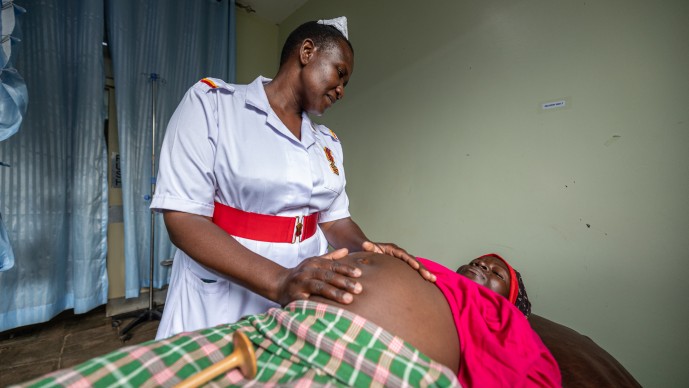Reducing the Burden of Preeclampsia

Before applying, applicants should familiarize themselves with the supporting documents for this Grand Challenge, including the terms and conditions of the Gates Foundation, the Rules and Guidelines, Application Instructions, and Frequently Asked Questions.
If you are planning to apply to this RFP, we will be hosting a dedicated webinar on February 27, from 7:30 to 8:30 AM Pacific Time. This session will provide a comprehensive overview of the RFP details and an opportunity to have your questions answered. To participate in the webinar, please register and submit your questions in advance. If you cannot attend live, the webinar will be recorded and available on this challenge page after the session.
Background
Preeclampsia is a leading cause worldwide of maternal morbidity and mortality, premature birth, stillbirth, and neonatal death. Preeclampsia is a placental disease caused by two different pathologies during pregnancy. Early-onset disease, caused by reduced uteroplacental blood supply, is a major driver of fetal mortality. Late-onset disease, caused by increased fetoplacental demands, is a major driver of maternal morbidity and mortality. These two pathologies converge on elevated levels of the protein sFlt1 and concomitant decreases in PlGF.
This mechanistic understanding is being translated into new strategies to reduce the burden of preeclampsia. Therapeutic candidates are being developed that target sFlt1 activity, and levels of this protein can be used in screening for preeclampsia risk. Effective screening and low-dose aspirin therapy early in pregnancy has been shown to prevent early-onset preeclampsia and to ameliorate the disease's consequences for the fetus.
Despite the growing understanding of preeclampsia biology, questions remain about heterogeneity of the disease across patients and the degree to which there are distinct subtypes and etiologies. New approaches are also needed to more quickly and comprehensively reduce the burden of preeclampsia, especially those suitable for the health care infrastructure in the countries with the highest burden.
The Challenge
We seek proposals for innovative solutions for the early detection, prevention, and treatment of preeclampsia, particularly in low- and middle-income countries where maternal mortality rates are high. To support this focus, we are looking for collaborations, including those with research institutions, health care providers, and global health organizations, that enable cross-sector insights and ensure that solutions are adaptable and practical.
The objectives of the challenge are:
- Early prediction and detection of preeclampsia. We seek novel biomarkers as well as novel approaches to measurement of sFlt1 and PlGF, diagnostic tests, and point-of-care technologies to predict early in pregnancy the risk of preeclampsia and to diagnose it before symptoms become severe.
- Understanding the pathophysiology of preeclampsia and its heterogeneity. We seek to understand the biological mechanisms driving the disease and its subtypes so that new interventions can be effectively tailored to the underlying etiology.
- Preventive and therapeutic interventions. We seek new approaches to known targets or new targets to reduce the incidence and severity of preeclampsia, mitigate disease progression, and prevent the cardiovascular and metabolic complications that often follow it.
Funding Level
We will consider proposals for awards of up to $500,000 USD for each project, with a grant term of up to 2 years. Application budgets should be commensurate with the scope of work proposed. Indirect costs will be considered, and should be included in the budget for the up to $500,000 USD award (subject to the Gates Foundation's indirect cost policy).
Eligibility Criteria
This initiative is open to nonprofit organizations, for-profit companies, international organizations, government agencies, and academic institutions. We particularly encourage applications involving projects led by women or from women-led organizations and applications from institutions based in low- and middle-income countries.
We are looking for proposals that:
- Identify biomarkers that easily, reliably, and affordably predict preeclampsia risk early in pregnancy
- Identify biochemical, genetic, epigenetic, or metabolomic signatures that can be translated into point-of-care tests
- Leverage innovations in mobile health, wearable sensors, or simple clinical algorithms to identify women at risk before symptoms become severe
- Identify the underlying biological mechanisms driving preeclampsia and its subtypes, including the roles of the placenta, endothelial function, immune response, and gut microbiota
- Identify preventive interventions synergistic with or additive to low-dose aspirin, such as nutritional, pharmacological, or lifestyle-related approaches to reduce the incidence or severity of preeclampsia
- Identify new drug candidates, therapeutics, or repurposed medications that safely mitigate preeclampsia progression without harming the fetus
We will not fund proposals that:
- Focus on implementation science, health systems integration, or social determinants (although these are all important elements, they are not in the scope of this request for proposals)
- Do not have the potential to become affordable and scalable in resource-limited settings
- Represent basic research without clear relevance to the objectives of this challenge
- Lack a clearly articulated and testable hypothesis
- Present unacceptable safety risks or detract from or interfere with beneficial practices
- Approaches that leverage previously failed biomarker exploration